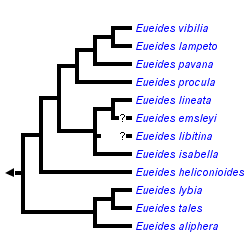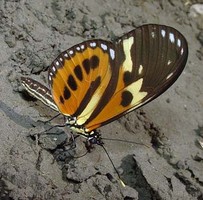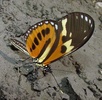Eueides
Margarita Beltrán, Chris Jiggins, and Andrew V. Z. Brower


This tree diagram shows the relationships between several groups of organisms.
The root of the current tree connects the organisms featured in this tree to their containing group and the rest of the Tree of Life. The basal branching point in the tree represents the ancestor of the other groups in the tree. This ancestor diversified over time into several descendent subgroups, which are represented as internal nodes and terminal taxa to the right.

You can click on the root to travel down the Tree of Life all the way to the root of all Life, and you can click on the names of descendent subgroups to travel up the Tree of Life all the way to individual species.
For more information on ToL tree formatting, please see Interpreting the Tree or Classification. To learn more about phylogenetic trees, please visit our Phylogenetic Biology pages.
close boxIntroduction
Etymology: Euides means shapely, comely (Eueides). From the greek prefixes eu- good , favourable , easy (Lederer, 1967) and the greek adjectival suffix –eides- eidos that means form (Creisler, 1996).
Characteristics
Early stages: The larvae are similar to Heliconius, except that they are more colourful and feed only on mature leaves. The larvae are solitary in some species, gregarious in others, and seem to show indications of larval mimicry in some species (i.e., Eueides vibilia vialis in Costa Rica). The pupae are highly distinctive, with four dorsal spines that are usually spread out into a X shape, and a strong curve to the abdomen that causes suspended pupae to be held horizontally to the substrate (DeVries, 1997) (see each species for more details).
Adults: The butterflies in this genus are similar to Heliconius but are recognized by the smaller size, a relatively short body, and short antennae (see each species for more details). The colour patterns show mimetic resemblance to tiger-striped species, Heliconius and Actinote, and others seem to form mimicry complexes with Dryas and other Eueides species (DeVries, 1997).
Discussion of Phylogenetic Relationships
The topology shown is based upon the molecular systematic results of Brower and Egan (1997) and Beltrán et al. (2007).Geographical distribution
The genus ranges from Mexico through Central and South America and the West Indies, and most are found in the Amazon Basin (DeVries, 1997) (see maps attached to each species).
Habits
Eueides species are mostly canopy-flying insects and tend to live in localized populations near the hostplant.
Hostplants: Eueides larvae feed on Passifloraceae and Turneraceae; host plants include vines and trees (Brown, 1981; DeVries, 1997) (see each species for more details).
References
Beltrán, M., Jiggins, C. D., Brower, A. V. Z., Bermingham, E. & Mallet, J. 2007 Do pollen feeding, pupal-mating and larval gregariousness have a single origin in Heliconius butterflies? Inferences from multilocus DNA sequence data. Biol. J. Linn. Soc. 92, 221-239.
Brower, A. V. Z. & Egan, M. G. 1997 Cladistics of Heliconius butterflies and relatives (Nymphalidae: Heliconiiti): the phylogenetic position of Eueides based on sequences from mtDNA and a nuclear gene. Proc. R. Soc. Lond. B 264, 969-977.
Brown K. S. 1981 The Biology of Heliconius and Related Genera. Annual Review of Entomology 26, 427-456.
Creisler B. 1996 The Etymology of Chelodina Fitzinger, 1826 (Testudines: Chelidae. Journal of Herpetology, Vol. 30, No. 4 (Dec., 1996), pp. 556-556.
DeVries P. J. 1997 The Butterflies of Costa Rica and Their Natural History, Volume I: Papilionidae, Pieridae, Nymphalidae Princeton University Press, Baskerville, USA.
Eueides. The Main-Word Info page. http://www.wordinfo.info/words/index/info/view_unit/705 [Accessed Agust 16, 2008].
Hübner J. 1816. Verzeichniss bekannter Schmettlinge [sic]. Augsburg, Jacob Hübner. (1): 1-16 (21 September-31 December)
Lederer R. 1967 Shaping the Dystopian Nightmare.The English Journal, Vol. 56, No. 8 (Nov., 1967), pp. 1132-1135.
Title Illustrations

| Scientific Name | Eueides heliconioides |
|---|---|
| Location | Peru: Manu, Cock-of-the-Rock Lodge |
| Specimen Condition | Live Specimen |
| Identified By | Kim Garwood |
| Behavior | puddling |
| Life Cycle Stage | adult |
| View | dorsal |
| Source | Heliconioides Longwing (highlands) (Eueides heliconioides heliconiodes) |
| Source Collection | Neotropical Butterflies |
| Copyright | © 2004 Kim Garwood |
| Scientific Name | Eueides isabella |
|---|---|
| Location | Peru: Atalaya, Amazonia Lodge |
| Specimen Condition | Live Specimen |
| Identified By | Kim Garwood |
| Behavior | puddling |
| Sex | Male |
| Life Cycle Stage | adult |
| View | ventral |
| Source | Isabella's longwing (Eueides isabella) |
| Source Collection | Neotropical Butterflies |
| Copyright | © 2004 Kim Garwood |
About This Page

University of Cambridge, Cambridge, UK
Chris Jiggins

University of Cambridge, Cambridge, UK

Middle Tennessee State University, Murfreesboro, Tennessee, USA
Correspondence regarding this page should be directed to Margarita Beltrán at , Chris Jiggins at , and Andrew V. Z. Brower at
Page copyright © 2013 , Chris Jiggins, and
 Page: Tree of Life
Eueides .
Authored by
Margarita Beltrán, Chris Jiggins, and Andrew V. Z. Brower.
The TEXT of this page is licensed under the
Creative Commons Attribution-NonCommercial-ShareAlike License - Version 3.0. Note that images and other media
featured on this page are each governed by their own license, and they may or may not be available
for reuse. Click on an image or a media link to access the media data window, which provides the
relevant licensing information. For the general terms and conditions of ToL material reuse and
redistribution, please see the Tree of Life Copyright
Policies.
Page: Tree of Life
Eueides .
Authored by
Margarita Beltrán, Chris Jiggins, and Andrew V. Z. Brower.
The TEXT of this page is licensed under the
Creative Commons Attribution-NonCommercial-ShareAlike License - Version 3.0. Note that images and other media
featured on this page are each governed by their own license, and they may or may not be available
for reuse. Click on an image or a media link to access the media data window, which provides the
relevant licensing information. For the general terms and conditions of ToL material reuse and
redistribution, please see the Tree of Life Copyright
Policies.
- First online 29 October 2006
- Content changed 25 February 2009
Citing this page:
Beltrán, Margarita, Chris Jiggins, and Andrew V. Z. Brower. 2009. Eueides . Version 25 February 2009 (under construction). http://tolweb.org/Eueides/70440/2009.02.25 in The Tree of Life Web Project, http://tolweb.org/







 Go to quick links
Go to quick search
Go to navigation for this section of the ToL site
Go to detailed links for the ToL site
Go to quick links
Go to quick search
Go to navigation for this section of the ToL site
Go to detailed links for the ToL site